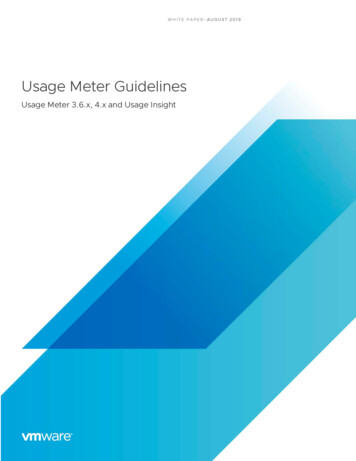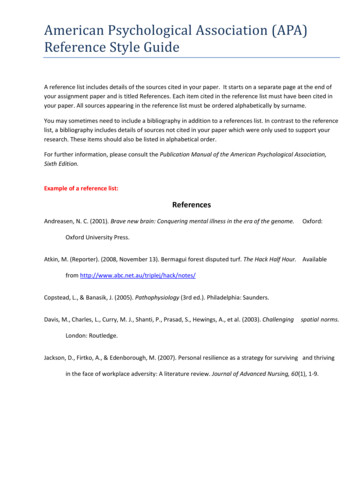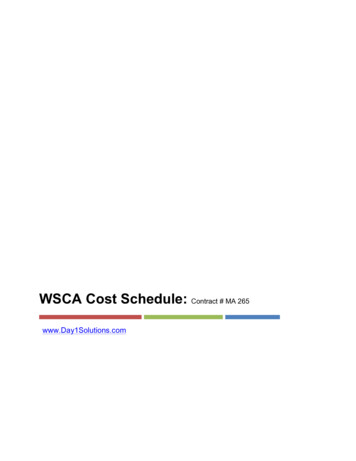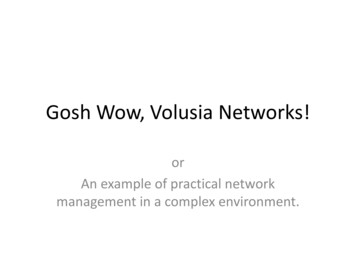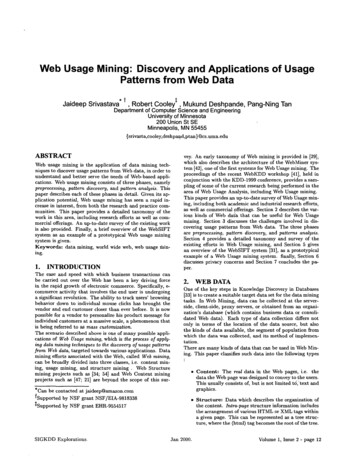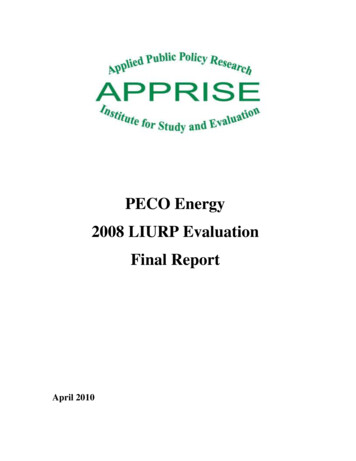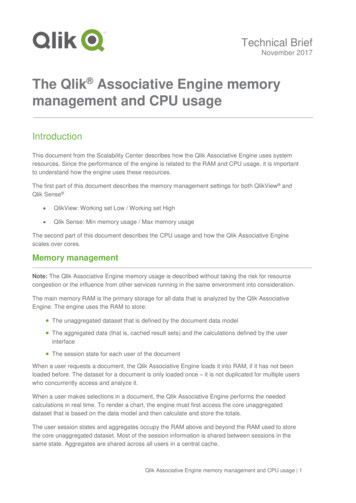
Transcription
netLibrary eBook Usage at theUniversity of Rochester LibrariesVersion 29/27/01Two studies were conducted over the Spring 2001 (January – May) semester regarding theuse of netLibrary ebook titles. The first was to examine the use of the overall netLibraryebook collection and compare that to the use of the paper editions of those same titles.The second study focused on the use of ebooks for course reserves.Study 1: Overall Ebook CollectionSize and Make-up of the netLibrary Collection: The University of Rochester Libraries hasshared ownership of a collection of 3,613 netLibrary ebook titles. A consortium of sixtytwo academic, special, public and school libraries throughout New York State, which wascoordinated by Nylink, a regional OCLC-affiliated network, purchased these titles.Nylink made title selection with the input of the participating libraries. Although thecollection spans a very wide spectrum of subjects, there are concentrations in ComputerScience, Business & Economics, History and Sociology. Since the ebook collection is ashared one, only one patron from any participating library can view an ebook title at agiven time. In other words, if a patron from Brooklyn CUNY is viewing an ebook, then apatron from the University of Rochester is blocked from the title.In January through March, the University of Rochester’s Management Library participatedin a netLibrary trial. This trial provided access to an additional 618 ebook titles within thefields of management, business and economics, bring the total number of ebooks availableto members of the University of Rochester community to 4,231Access and Promotion: MARC records for the entire netLibrary collection were loadedinto the University of Rochester’s Voyager catalog in late January. In the prior fivemonths when the collection was not represented in the Voyager catalog, the ebooks had atotal of only 397 accesses from the University of Rochester. In the five months followingthe MARC record load, the University of Rochester has had over 3,000 accesses—a 755%increase in use. The University of Rochester was one of the few libraries within theNylink consortium to load the MARC records into its catalog. This probably accountsfor the fact that the University of Rochester attributed for more than 16% of the totaluse of the ebook collection, though it was only 1 of 62 participating libraries.In addition to the MARC records, the netLibrary ebook collection was promoted throughthe Libraries’ website and bibliographic instruction classes. However, our experiences, aswell as those reported by other institutions, strongly suggest that inclusion of the ebooktitles within a library’s catalog is directly tied to a high increase in use of the collection.Library Recommendation 1: All ebooks should be represented in a library’s catalog.Data collection: Using netLibrary’s “Library & Resource Center,” an activity report wasgenerated at the end of each month. The report recorded the number of accesses duringthat month for each title in the collection, as well as the number of turnaways (number oftimes a patron was denied access to a title because it was already in use).
Month# of AccessesJanuary 2001February 2001March 2001April 2001May 2001TOTAL4499137295713903,052# of Unique TitlesAccessed in that Month191290287237159# of Turnaways23 (8 titles)56 (22 titles)81 (19 titles)62 (28 titles)142 (23 titles)364Unfortunately, the usage statistics that netLibrary supplies lack details that could helpdetermine how the ebooks are being used. For instance, it is not possible to determinethe length of time an ebook is used. Did the patron read the ebook for 2 minutes or 2hours? Nor do the usage stats reveal who is using the ebooks. Do 12 accesses on a titlerepresent the same person using an ebook 12 times or did 12 different people open theebook? Data of this type would be very useful in better understanding how patrons areusing ebooks and why.netLibrary Recommendation 1: Expand the types of usage data available in its “Library &Resource Center” to include information about how the ebooks are being used (i.e.duration of access; how many different patrons accessed; number of different pagesviewed within a text; type of search that led patron to the title, etc.)In addition to the regular collection of usage statistics, a link to a web-based, “netLibraryAssessment Survey” was placed on the University of Rochester’s branded netLibraryhomepage. The purpose of the survey was to assess how patrons were using the ebooks,the pathways they followed to reach the ebooks and whether the patron believe theLibraries should continue to purchase ebooks (copy of the survey in Appendix A).Findings & Conclusions: Overall, participation in a consortial purchase of netLibraryebooks was beneficial. The University of Rochester used 757 different titles, or 18% ofthe total collection, during the Spring 2001 semester. Each member of the consortium hada very small voice in determining what titles would be included in the collection. As aresult, the majority of titles (82% or 3,474 titles) were of no use or interest to patrons ofthe University of Rochester Libraries. However, some of the ebook titles that werepopular on the University’s campuses were titles that likely would not have been placedinto the collection if the University of Rochester compiled it. For instance, the Universityof Rochester Libraries owned (in paper) only one of the ten netLibrary ebooks mostfrequently accessed by its patrons (see Appendix B). In other words, because thenetLibrary ebook collection did not exactly mirror the collection development policies ofthe Libraries’ print collection, previously unrecognized areas of patron interest wererevealed, such as gaming theory and IT titles.Moreover, the consortial pricing permitted the University of Rochester to purchaseperpetual access to these ebook titles at a considerable discount. Had the University ofRochester used the same amount of money to purchase its own netLibrary ebookcollection, it would have a collection of approximately 155 titles- not 5,000 (a final batchof ebook titles is expected to be added to the collection in early fall 2001, bringing the
total to 5,000 titles). The University of Rochester has paid approximately 1.73 per title,and the only processing cost was the time of one staff person to load the MARC recordsinto the catalog. If only the titles used by the University of Rochester are counted, thecost per title is 11.44, which is still significantly cheaper than the price of the paperversion of the book, as well as netLibrary’s non-consortial pricing (1.5 times the hard backlist price).Library Recommendation 2: Consider additional consortial purchases of ebooks as aeconomical and easy means to build critical mass in an ebook collection.The ebook titles that had the most usage fell with the following subject areas:SubjectTotal # of AccessesEconomics & BusinessComputer ScienceTechnology & EngineeringPsychologyMedicine, Health &WellnessLiteratureAnatomy & PhysiologySociologyEducation765 (310 for 1 title)665161136104Total # of Unique TitlesAccessed14713640234710070665561153425(Go to tm for a full breakdown.)The majority of computer science and technology & engineering titles are of the type thatthe University of Rochester Libraries would not naturally purchase, such as Practical C Programming and Sams Teach Yourself Illustrator 8 in 24 Hours. This is because these IT(information technology) titles quickly go out of date and are rarely on the shelf whenneeded by a patron. However, for these very same reasons, it does not make sense to tryto build a collection of IT books using netLibrary. A collection of titles purchased fromnetLibrary is a static collection. Therefore, within a year or two, most of the IT ebookthat the University of Rochester currently has access to from netLibrary will be too datedto be of use. No one will want to read Using Visual J 6 when there is a Using VisualJ 7 . Furthermore, the non-consortial pricing of a netLibrary title is 1 ½ times the listprice of the paper edition. Wht pay 1 ½ times more for an ebook edition, when it willbecome obsolete as quickly as the cheaper paper edition? Moreover, 42.5% of theturnaways were for IT titles. As with paper-based books, patrons were frustrated by thefact that they could not get access to IT books because someone else was using them.Although the usage statistics reveal a strong interest in IT ebooks, netLibrary’s modelsuffers from the same limitations as a traditional brick-and-mortar library.Library Recommendation 3: netLibrary usage statistics indicate that patrons find theebook format to be an acceptable format for IT title. Libraries should considerpurchasing access to an ebook collection of IT titles that 1) supports multiple,simultaneous users and 2) include new editions of titles as published, such as Books 24x7.(See Appendix C)
The user surveys revealed that 63% (19/30) had difficulties using netLibrary. Theirproblems included frequent browser crashes, slow load times, copyright violation noticesappearing at inappropriate times and difficulties navigating through text. The number ofreported difficulties was elevated by the fact that some patrons reported the narrow rangeof the collection and checked-out titles as difficulties. Moreover, it is more often thedissatisfied user, rather than the satisfied user, who completes a user survey. But withthat said, it appears clear that a patron’s experience with netLibrary is greatly impacted bythe quality and speed of netLibrary’s server, and complaints of slow load times andfrequent crashes are not unique to the University of Rochester. In May, Rob Kaufman,CEO of netLibrary, announced that his company was planning a significant upgrade totheir technological infrastructure in order to provide faster, more reliable connectivity. Ifthey are successful in this upgrade, many of the connectivity difficulties should beeliminated. In spite of the many difficulties reported, a surprising 22 of 26 (85%) whoresponded to the question believe that the Libraries should purchase additional ebooktitles.Only 29% (9/31) reported reading large portions of ebook titles. Most either browsedthrough one or more titles or searched for a single term across the collection. Thiscorresponds with the general findings that most people are not comfortable reading largeportions of text on a computer screen. Unfortunately, netLibrary limits printing to50,000 characters at a time, making it cumbersome to obtain a paper copy for off-screen reading.Library Recommendation 4: Purchase of additional ebook titles should not includedense, scholarly monographs, but rather titles that can be used in small segments, such asinstructional (The Complete Guide to Natural Sleep), IT (Using Visual J 6) ortextbook titles (Mergers and Acquisitions from A to Z).An obvious advantage of an ebook over the paper format is the immediate availability ofthe title once it is checked back in. For instance, the most popular netLibrary title wasMacroeconomics by Robert J. Barro. The title was accessed 310 between January 1st andMay 31st, 2001. Physical circulations of this magnitude simply are not possible with paperbooks. Moreover, ebooks are never lost, stolen, damaged or misplaced.Library Recommendation 5: Libraries should purchase the ebook format for heavilycirculating titles, when available. If the ebook titles are given short circulation periods,such as one day, a greater number of patrons would have access to the book in a givenperiod of time.Study 2: Ebooks on ReserveIn January, a list of the monographs on course reserve at the Rush Rhees Library,University of Rochester, in Spring 2001 was compared with a list of currently availablenetLibrary titles. A total of seventeen titles from ten different courses were found incommon. These titles were purchased with funds from the River Campus Librariescollection budget and the LSTA Electronic Book Evaluation Project grant. The averagecost of perpetual access for the titles was 70.68, as there were no consortial purchasingoptions. The MARC records for these titles were added to the Voyager catalog and the
titles were listed in the Course Reserve module along with the paper format of the title.The circulation periods of the ebooks were set to mirror the circulation periods of thepaper versions of the book. Therefore, students were provided with the option of eitherthe paper or ebook version of their course reserve titles, which had identical circulationperiods.The students in each of the ten classes received a handout during the first week of classeswhich detailed their options of either paper or ebook reserve titles and explained hownetLibrary titles were located and accessed. (Copy of handout in Appendix D). At theend of the semester, the students were asked to complete a survey (Appendix E). Inaddition, usage stats for the ebook and paper formats of each title were compiled on aweekly basis.Findings & Conclusions: When given the choice, 3 to 1 (66 to 183 circulations) studentsopted for the ebook over the paper versions of their course reserve reading. Of the thirtysix returned surveys, 44% (16 of 36) reported reading material from the ebook version oftheir course reserves material. Of those who did use the ebooks, only three reported anydifficulties (slow connectivity and title always checked out). Surprisingly, only four of thesixteen found it uncomfortable to read their course materials from a computer screen.This would suggest that the assigned readings were no more than a chapter or two.When asked whether they preferred their course reserve material in paper or ebookformat, 17 selected paper and 14 indicated ebook. Reasons for the paper preferenceincluded 1) having a personal copy for quick reference; 2) not as harsh on the eyes; and 3)does not require ownership of a computer and Internet connection. Several students alsoindicated that they preferred the paper format so that they could highlight and annotatethe text. This suggests that many students are unaware of annotation features innetLibrary’s off-line Reader.netLibrary Recommendation 2: Details or a teaser about the annotation tools in theirnetLibrary Reader should be included on their homepage and the “Reading Room”section of their website.In spite of a slight majority indicating a preference for paper books, an overwhelming 25out of 26 respondents believe the Libraries should continue to purchase ebooks for use oncourse reserve. Although they personally might not want to read an ebook, thestudents seemed to see the value of ebooks for other students. Unfortunately, when thestudents explained the reasons why they preferred ebooks or supported the Libraries’additional purchases of them, it became apparent that the students did not fullyunderstand the limitations of netLibrary. For instance, more than once a student citedthe benefit of not having to wait if something is already checked out. In actuality, nomore than one user can view a netLibrary title at any given time. In addition, studentsliked ebooks because “it saves the student money.” What these students are actuallyreferring to is the fact that the Libraries do not charge for printing, but do charge forphotocopying. Therefore, if a student could print out his/her reserve reading from acomputer rather than photocopy it, he/she would save money. However, netLibrary’scopyright protection limits printing to less than 50,000 characters at a time, so that theprinting of most reading assignments would be time consuming. Students assumed that
the netLibrary ebook titles had the same accessibility and functionality as the scannedarticles in .pdf format on reserve. If the students better understood the limitations tonetLibrary’s printing andaccessibility, they might not be as enthusiastic about netLibrary.This is not to say that all of the students’ favorable comments about ebooks were basedon misconceptions. Many students commented on the convenience of ebooks which areaccessible online when the library is closed and do not require a physical visit to thelibrary.An ideal ebook system for use for course reserves would be one that would allow forsimultaneous users or had a pricing model that would permit multiple copies to be rentedfor the semester. In addition, printing must be possible to allow students to have apersonal copy (for educational purposes) that they could annotate and carry to class. Suchan ebook system does not yet exist, although elements can be found scattered throughoutthe combined models of netLibrary, Questia and ebrary. So perhaps the realization ofsuch an ebook system is not too far in the future.Library Recommendation 6: The cost and functionality of ebooks is not yet at a level tomake it cost effective to purchase ebook titles for use on course reserves. Exceptionscould be made for a title that is going to be on reserve for several semesters and/or atitle that would have heavy usage from a large class of students.Submitted by Susan GibbonsDigital Initiatives LibrarianUniversity of Rochester&LSTA-Funded eBook Project DirectorSeptember 10, 2001mailto:sgibbons@rcl.lib.rochester.edu
Appendix AnetLibrary Assessment SurveyPlease take a moment to fill out this short survey in order to help us determine how thecollection is being used and the level of interest innetLibrary ebooks.1- Did you have any difficulties using netLibrary? Yes No1a- If yes, please explain the difficulties you had.2- How did you use the netLibrary ebooks? (check all that apply) Browsed through one or more titles Searched for a single term or concept across the collection Read large portions of a title3- How did you get to the netLibrary system? Course Reserve List in Voyager Author, title, subject or keyword search in Voyager Library's "eBook" webpage Other- Please specify:4- What types of books did you use? (check all that apply) Scholarly texts Reference books (e.g., dictionaries, encyclopedias) Textbooks Instructional books (i.e. Java Programming for Dummies)5- What types of searches did you do? (check all that apply) Title Author Keyword Full Text Publisher ISBN Publication Year6- Would you like to see netLibrary titles added to the electronic course reservescollection, in addition to the paper text, whenever possible? Yes NoComments:
Appendix AnetLibrary Assessment Survey(continued)7- Should the library purchase additional netLibrary titles? Yes NoComments:8- Please indicate your status. Faculty Staff Undergraduate Student Graduate Student Alumni OtherAdditional comments:
Appendix BTitleSubjectPublisherPub ISBNDateMacroeconomicsEconomics &BusinessPsychologyMIT Press19970262024365PsychologyPressMacmillanUSA, Inc.MIT ssentials of HumanMemorySams Teach YourselfComputerVisual C 6 in 24 Hours ScienceStrategies & GamesEconomics &BusinessWindows NT TCP/IPTechnology &Network AdministrationEngineeringSams Teach YourselfComputerVisual Basic 6 in 21 Days ScienceSams Teach YourselfComputerMicrosoft Access 2000 in Science24 HoursExploring JavaComputerScienceUsing Microsoft AccessComputer2000Science175 High-Impact Resumes Economics &BusinessO’Reilly &AssociatesMacmillanUSA, Inc.Macmillan,USA, Inc.O’Reilly &AssociatesMacmillanUSA, Inc.John Wiley& Sons, Inc.# ofCopies UROwns# of LifetimeCircs in PaperFormat# of ebookCircs in Spring20012 (1 ismissing)Copy onorder013310N/A90N/A61N/A511565923774Copy 13147650N/A21
Appendix CBooks 24x7 is a collection of approximately 1,000 IT titles. UnlikenetLibrary, a subscribing library has access to a constantly growing collectionof titles. The newest editions of titles are added to the collection uponavailability, while the older titles are kept in the collection for futurereference. Moreover, an unlimited number of simultaneous users can accessa title at any given time.WALDO, the Westchester Academic Library Directors Organization,provides consortial purchasing of Books 24x7 for academic, public special andK-12 libraries within New York State. A yearly subscription for Books 24x7through WALDO is 0.62 per FTE. For the University of RochesterLibraries, this would translate to approximately 4466 per year.The following is a brief fact sheet on Books 24x7.
The IT Pro Collection for LibrariesTHE #1 WEB REFERENCE SOLUTION!Challenged by the need to remaincurrent with the swiftly moving target oftechnical reference content? The IT ProCollection for Libraries, fromBooks24x7.com, enables noncommercial libraries to instantly deliverthe most comprehensive collection ofbest-in-class technicalreference content totheir patrons.The IT Pro Collectionfor Libraries providesweb access to the fulltext of books, journals,reports and more fromthe world’s toppublishers, includingIDG, MIT Press,O'Reilly, Osborne, McGraw-Hill,Microsoft Press, Que, Sams, Sybex,Wiley and many others.COMPLETE AND CURRENT CONTENTOur subscription service delivers themost complete and trusted contentavailable today on the web. We coverover 90 different technology verticals --all in a fully searchable format that doesnot require downloads or plugins.PATENT-PENDING SEARCH TECHNOLOGYPinpointing trusted technical answershas never been easier. Our patentpending technology enables your patroncommunity to: Search for a specific word or phraseacross the entire collection, within atopic, or within a specific book,journal, or other source. Relevancybased icons guide users directly tothe most relevant content chapters,sections, and sub-sections. Browse down the topic hierarchy tofind particular subject content. Read any and all content sections. Preview content and read reviewsfrom other community members. Print sections ofcontent. Read exclusivereviewsauthored by ourworld-classEditorial Board.CUSTOMIZED LIBRARY SERVICESIn addition to the industry’s mostcomprehensive collection of currentcontent, the IT Pro Collection forLibraries is designed to help you serveyour patron community with support for: MARC Records (856 tag)IP AuthenticationSimultaneous UsageRemote Patron AccessCourse Pack DevelopmentOptional Personal &Collaboration CapabilitiesCAN’T BEAT THE VALUE!An annual subscription providesauthorized users with online access tothe IT Pro Collection for Libraries.Unlike other check-in, checkoutservices, our content is always availableto multiple authorized users!HOW TO CONTACT x7.com781-440-9330 (voice) 781-440-0560 (fax)
FEATURESBENEFITSContentIT Pro Collection for Libraries:1000 titles with weekly additions. Coverage of over 90different topic areasContent Partners:O'Reilly John Wiley Macmillan Osborne MIT Press McGraw-Hill Sybex Artech House Waveside Prima Digital Press Nolo.com Thomson Learning AutoDesk OnWord Morgan Kaufmann PeachPit ZD Journals IDG Muska Lipman Microsoft Press AMACOMSITE DESIGNClean simple designFree of Distracting Banner AdsSEARCH TECHNOLOGYFull-text searching across the entire library, within a specific topic,within a specific content section, or within a search result setLookup content by title, author, ISBN, or publisherBrowse by topicSEARCH RESULTSRelevancy ranked search results by subject, topic, and specificcontent selectionsRelevant chapters/sections presented within appropriate contextOne click access to Table of Contents and to relevant sectionsand one click access back to results listPRESENTATIONContent presented in context of chapters, table of contents, andappendicesContent displayed with full graphics, code, and complete text.Images expandable to full sizeFonts and images optimized for screen viewingNAVIGATIONLinks embedded within content for quick jumps to other pertinentinformationNavigational aids and markers consistently in view during contentviewing processSingle click access to move from chapter to chapter or section tosectionUSMARC RECORDSUSMARC records with 856 tagComprehensive coverageHave confidence in the quality ofinformation when it's from trustedsources.Be more productive - spend less timenavigating, find pertinent informationfaster; and don’t be distracted byextraneous information.Save time with sophisticated searchingand lookup capabilities, which providerelevant results first time.Find information faster: Complete contentinformation helps in the decision processand fewer clicks are required to get to thepertinent information.Users spend less time finding their wayaround the content with a familiar andconsistent format.On-screen reading is optimized by text andimage presentation.Save time with quick, easy and consistentnavigation within a book and from book tobook.Links from library catalogue ensure usersare directed to appropriate information.MEMBERSHIP BENEFITSOptional username and password registration provides ability tocreate a personal content shelf, make annotations and shareinformationUsers can quickly refer to previous usedtitles and annotations and faculty canidentify titles, create notes, and share withstudents.Exclusive book synopses provided by world-class Editorial BoardUsers can determine if content meetstheir needs or experience levels.
Appendix DThe following is an example of a handout that was given to each studentenrolled in a course that had an ebook title on reserve.
Course: EDU492Professor: H. WechslerRecently, the University of Rochester Libraries purchased a collection of electronicbooks (ebooks) from netLibrary. Whenever possible, we have included into thiscollection any title that a professor wants on reserve for his/her course. In additional tothe paper copies, the ebook versions are also available for the following books on reservefor EDU492: Cook, Constance Ewing. Lobbying for Higher Education: How Colleges andUniversities Influence Federal Policy. Nashville: Vanderbilt University Press, 1998Rhoades, Gary. Managed Professionals: Unionized Faculty and RestructuringAcademic Labor. Albany: State University of New York Press, 1998These titles are listed on your professor’s Course Reserves listing in Voyager, theLibrary’s catalog (go to the Library’s homepage http://www.lib.rochester.edu and clickon Course Reserves). When you select an ebook title from the course reserves list, youwill see the following information:By clicking on the Internet Link, you will be taken to netLibrary’s “About This Book”page:
Each of these electronic books (ebooks) can be checked out for the same length of time asyour professor has indicated for the paper copies. To check out ebooks, first you need tocreate an account. This account must be created using any computer on the University ofRochester campus. Once you have created an account, you can access these ebooks fromany computer with Internet access by first logging in. To create an account, click on"Create Account" at the top of the page:Once an ebook has been checked-out, you have the option to read it on-line or downloadit onto your personal computer and read it off-line for the duration of your check-outperiod. To read off-line, you must first download the netLibrary eBook ReaderTM freesoftware onto your computer. This software provides the ability to make notes, copy andpaste text, print sections of the book and facilitates the creation of citations andbibliographies. Go to http://www.netlibrary.com/nl ebook reader.asp for moreinformation.As this is the first time that we have included electronic books into our reservescollection, we are very eager to receive your input. Therefore, please pass along yourcomments and experiences to any library staff member. For more information orassistance, contact Susan Gibbons, Digital Initiatives Librarian at 275-6320 orsgibbons@rcl.lib.rochester.edu.
Appendix EElectronic Books on Course ReserveStudent Assessment SurveyPlease take a few minutes to answer some questions about your experiences this semesterusing electronic book (ebook) editions of course reserve materials. Your answers will beused by the Library to help assess its future purchases of ebooks. Please note: thesereserve.1) Did you use the ebook version of any of your course reserve books?Yes No1a) If no, why not?2) What difficulties, if any, did you have accessing the ebooks?3) Did you find it uncomfortable to read course reserve materials off of a computerscreen? Yes No I did not use the ebooks4) Given the option, would you prefer to read the ebook or paper version of a book?Please explain why.5) Do you believe the Library should continue to purchase ebooks for course reserveswhen possible? Please explain why.Thank you very much for you time!
months when the collection was not represented in the Voyager catalog, the ebooks had a total of only 397 accesses from the University of Rochester. In the five months following the MARC record load, the University of Rochester has had over 3,000 accesses—a 755% increase in use. The University of Rochester was one of the few libraries within the
